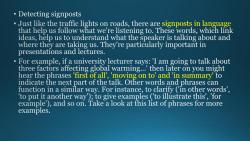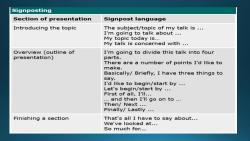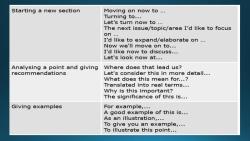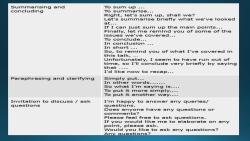《大学英语》课程教学课件(讲稿)Listen for the specific information

Listen for the specific information ·Predicting content If you are taking a listening test,skim through the questions first and try to predict what kind of information you need to listen out for.A question beginning 'How many.?,for example,will probably require you to listen for a specific number or quantity of something. ·Listening for gist(get the gist抓住要点) When listening,it is also possible to get the 'whole picture'but with one crucial difference:information comes in a sequence.And in that sequence of information,there are content words (the nouns, adjectives and verbs)that can help you form that picture.When you learn new words,try to group them with other words used in a similar context.Mind maps are good for this
information comes in a sequence group them with other words used in a similar context

·Detecting signposts Just like the traffic lights on roads,there are signposts in language that help us follow what we're listening to.These words,which link ideas,help us to understand what the speaker is talking about and where they are taking us.They're particularly important in presentations and lectures. For example,if a university lecturer says:'I am going to talk about three factors affecting global warming.'then later on you might hear the phrases 'first of all','moving on to'and 'in summary'to indicate the next part of the talk.Other words and phrases can function in a similar way.For instance,to clarify ('in other words', to put it another way');to give examples ('to illustrate this','for example'),and so on.Take a look at this list of phrases for more examples
signposts in language 'first of all', 'moving on to' and 'in summary

Signposting Section of presentation Signpost language Introducing the topic The subject/topic of my talk is. I'm going to talk about. My topic today is. My talk is concerned with. Overview (outline of I'm going to divide this talk into four presentation) parts. There are a number of points I'd like to make. Basically/Briefly,I have three things to say. I'd like to begin/start by. Let's begin/start by . First of all,I'll. .and then I'll go on to . Then/Next. Finally/Lastly . Finishing a section That's all I have to say about. We've looked at. So much for

Starting a new section Moving on now to . Turning to. Let's turn now to . The next issue/topic/area I'd like to focus on. I'd like to expand/elaborate on . Now we'll move on to. I'd like now to discuss. Let's look now at. Analysing a point and giving Where does that lead us? recommendations Let's consider this in more detail. What does this mean for.? Translated into real terms. Why is this important? The significance of this is. Giving examples For example,. A good example of this is. As an illustration,. To give you an example,. To illustrate this point

Summarising and To sum up . concluding To summarise. Right,let's sum up,shall we? Let's summarise briefly what we've looked at. If I can just sum up the main points. Finally,let me remind you of some of the issues we've covered. To conclude. In conclusion . In short . So,to remind you of what I've covered in this talk,. Unfortunately,I seem to have run out of time,so I'll conclude very briefly by saying that.· I'd like now to recap. Paraphrasing and clarifying simply put. In other words. So what I'm saying is. To put it more simply. To put it another way. Invitation to discuss/ask I'm happy to answer any queries/ questions questions. Does anyone have any questions or comments? Please feel free to ask questions. If you would like me to elaborate on any point,please ask. Would you like to ask any questions? Any questions?

Listening for details Decide on a type of detailed information you want to practise listening for and watch programmes where you would expect to get that information.For example,you could listen to a weather report to get details about the weather,or you could follow the sports news to find out the latest results. If you are taking a test,as soon as you get the question paper,skim through the questions,underline the important words and decide what kind of detail you need to identify in the listening text. ·Inferring meaning Using clues and prior knowledge about a situation to work out the meaning of what we hear. Take the following conversation: .A:Tom,did you do your homework? B:I did,sir,but the dog ate it. A:That's a terrible excuse.You'll never pass your exams if you don't work harder. We can infer from the use of the words 'homework'and 'exams'that this is a conversation between a student and his teacher.By using contextual clues and our knowledge of the world,we can work out what's being said,who is speaking and what's taking place
underline the important words • Using clues and prior knowledge about a situation
按次数下载不扣除下载券;
注册用户24小时内重复下载只扣除一次;
顺序:VIP每日次数-->可用次数-->下载券;
- 《大学英语》课程教学课件(讲稿)A digital detox.pdf
- 《大学英语》课程教学课件(讲稿)Unit 1 words and phrases to drill.docx
- 长治学院:《英语语音》课程教学资源(教案讲义).pdf
- 新疆大学:《汉英翻译》课程教学课件(PPT讲稿)第六章 语序的转换.ppt
- 新疆大学:《汉英翻译》课程教学课件(PPT讲稿)第九章 汉译英中标点符号.ppt
- 新疆大学:《汉英翻译》课程教学课件(PPT讲稿)第七章 汉语存在的翻译.ppt
- 新疆大学:《汉英翻译》课程教学课件(PPT讲稿)第四章 词的省略.ppt
- 新疆大学:《汉英翻译》课程教学课件(PPT讲稿)第八章 减词法 Economy of Expressions.ppt
- 新疆大学:《汉英翻译》课程教学课件(PPT讲稿)第五章 词性转换.ppt
- 新疆大学:《汉英翻译》课程教学课件(PPT讲稿)第二章 词的选择.ppt
- 新疆大学:《汉英翻译》课程教学课件(PPT讲稿)第三章 词的增补.ppt
- 新疆大学:《汉英翻译》课程教学课件(PPT讲稿)第一章 翻译启示录.ppt
- 新疆大学:《汉英翻译》课程教学课件(PPT讲稿)第十章 广告英译大观园.ppt
- 新疆大学:《汉英翻译》课程教学课件(PPT讲稿)第十二讲 正说与反说.ppt
- 新疆大学:《汉英翻译》课程教学课件(PPT讲稿)第十七讲 汉译英中标点符号的运用.ppt
- 新疆大学:《汉英翻译》课程教学课件(PPT讲稿)第十一章 科技英语的翻译特点.ppt
- 新疆大学:《汉英翻译》课程教学课件(PPT讲稿)第十四讲 汉语连动式的翻译.ppt
- 新疆大学:《汉英翻译》课程教学课件(PPT讲稿)第十六讲 汉语并列句的翻译.ppt
- 新疆大学:《汉英翻译》课程教学课件(PPT讲稿)第十五讲 新疆旅游资料翻译特点.ppt
- 新疆大学:《汉英翻译》课程教学课件(PPT讲稿)第十三讲 题目翻译.ppt
- 《大学英语》课程教学课件(PPT讲稿)How to Talk About the Past in English.pptx
- 《大学英语》课程教学课件(PPT讲稿)How to Tell a Story in English.pptx
- 《大学英语》课程教学资源(书籍文献)英语四级翻译(华研外语).pdf
- 《大学英语》课程教学课件(PPT讲稿)Describing People’s Appearance.pptx
- 《大学英语》课程教学课件(讲稿)Unit 2 Friendship language focus.docx
- 《大学英语》课程教学课件(讲稿)Unit 2 friendship words for drill.docx
- 《大学英语》课程教学课件(讲稿)Conditionals.pdf
- 《大学英语》课程教学课件(PPT讲稿)How to talk about movie and film in ENGLISH.pptx
- 《大学英语》课程教学课件(讲稿)Describe Your Hometown.docx
- 《大学英语》课程教学课件(讲稿)How to introduce your hometown.pdf
- 《大学英语》课程教学课件(讲稿)Time-order signal words and expressions.pdf
- 《大学英语》课程教学课件(PPT讲稿)unit 1 answers.pptx
- 《大学英语》课程教学课件(讲稿)Unit 3 language focus.docx
- 《大学英语》课程教学课件(PPT讲稿)unit 2 answers.pptx
- 《大学英语》课程教学课件(讲稿)Unit 3 words to drill.docx
- 《大学英语》课程教学课件(PPT讲稿)unit 3 answers.pptx
- 《大学英语》课程教学课件(PPT讲稿)How to Talk About Transport.pptx
- 《大学英语》课程教学课件(讲稿)transportation in your hometown.docx
- 《大学英语》课程教学课件(讲稿)Unit 6 language focus.docx
- 《大学英语》课程教学课件(讲稿)Unit 6 words to drill.docx
